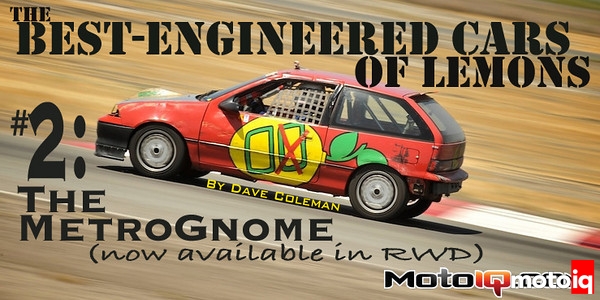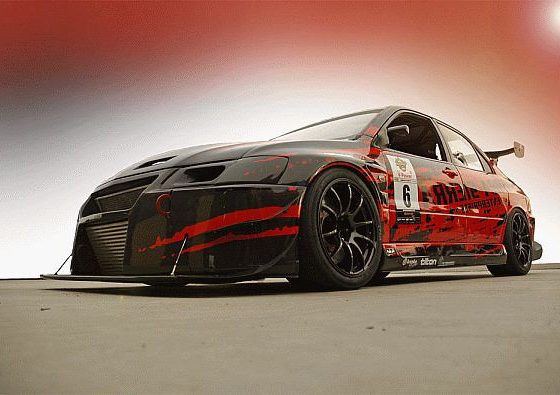,
MetroGnome 2.0, the “Holy Shit it’s Rear-Wheel Drive!” edition
 | ||
As a matter of fact, yes, it is loud in the car. Ear bleedingly loud. And a little warm. The fuel-injected CBR-1000 required a little more trickery to install. Everything from the bike was transferred to the Metro, including the catalyst and even a little solenoid that’s supposed to progressively open valves in the exhaust system to reduce restriction at high rpm. The valves are gone, but the ECU needs to see the solednoid (zip tied to the cage in the top-left of this photo) or else it will go into some kind of limp home mode. Note the gash in the lower right of the case and the JB weld holding the oil in. This is how you get a CBR-1000 engine on a LeMons budget. |
 | ||
 The 12-gallon fuel cell now residing in the front also needed surgery to feed the bike powerplant. The fuel pump mount and fuel outlet were cut from the top of the bike’s tank and welded into the fuel cell’s filler plate. The 12-gallon fuel cell now residing in the front also needed surgery to feed the bike powerplant. The fuel pump mount and fuel outlet were cut from the top of the bike’s tank and welded into the fuel cell’s filler plate. |
 | ||
| The CBR-900 had a cable actuated clutch, while the 1000’s clutch was hydraulic. Lacking funds to make a longer hydraulic line, Alex simply connected the cable, which was already rigged to the Metro’s clutch pedal, to the CBR brake handle. Sometime the simple soltuion is the best solution. |
 | ||
| The differential, axles, and janky steel mount were removed from the front of car and plopped between the rear wheels. With a longer chain (now as long as a drag bike’s), Alex is expecting a single chain to be strong enough. |
Now, if you were paying attention to the geometry discussion on the previous page, you’ll immediately see the problem here. When the suspension compresses, the ball joint will swing outward slightly. The toe control link will swing inward. Wth the toe link on the back, this means massive toe-out when the suspension compresses. | ||
|
 | ||
Connected to those uprights, of course, are struts, which have to go somewhere. The rear shock towers weren’t anywhere close to the right location, so they were removed and cage extensions are now used to mount the struts. Those small-diameter springs are trailer assist springs of some unknown spring rate. So, for the record, Stock Metro front struts at both ends, cut Metro springs up front, unknown trailer springs in the rear. So much for all that suspension tuning. |
 | ||
| At least the new mounting arrangement leaves lots of room for camber adjustability… |
 | Putting the engine in the passenger’s seat requires some packaging compromises. The differential couldn’t be mounted as far left as necessary without the engine occupying space normally required for the driver’s right arm. This eventually lead to an axle that was too short, and what appeared, at first, to be a pretty clean splice job to lengthen it. | |
| The cheap ERW mild steel tube used for the splice, though, was inadequate and ended the rear-drive gnome’s one test day early. A thicker piece of seamless DOM tubing is doing the job now. It might work. |
 | ||
The little details can eat your budget on a project like this, but not with an experienced bargain hunter in charge. Agricultrural hoses are much cheaper than automotive grade coolant hoses, and they’re rated to 200 psi. They might be able to survive the heat. Or they might not… The coolant path of a mid-engine car requires both radiator hoses to go low, through the tunnel, leaving a high point that can trap air bubbles on either end. The radiator cap solves the problem of the forward trap, but there is, as of now, no solution for the rear air trap. We expect a solution before the car’s debut race at Thunderhill. |
 | ||
| Front drive wheel bearings rely on the axle to hold the bearings together and keep them loaded properly. Wihtout an axle, the bearings will fall out or fail in minutes. Since Metro axles are so cheaply built they can’t be disassembled (apparently its a few pennies cheaper to swedge them togther than to contain them with a snap ring like any decent axle) Alex had to cut the outer joint off with a chop saw. |
 | There has, of course, been some dramatic, but so far undocumented change in weight distribution. Along with that change, the Metro now uses Metro front brakes at both ends. This, naturally, does wonders for the brake bias. Before buying a high-dollar brake proportioning valve (brake parts are exempt from LeMons budgeting), alex hit a junkyard regulator with a rock and discovered this adjustment mechanism hidden under a cover. The stock porportioning valve is actually adjustable! problem solved. | |
MetroGnome 2.0 debuts a Thunderhill on November 21. Despite the improved power and rear-drive corner exiting grip, its hard to imagine this ending in anything other than tears. That’t not a prediction, though. We’ve learned not to makre predictions about the MetroGnome.


 Getting drive to the rear wheels meant “simply” transplating metro front hubs to the rear. The stock rear control arm is still used, but the end of a front control arm is welded to it, providing a ball joint for the front hub to attach to. The car’s original rear toe control link was cut and welded to a tie rod, which goes to the front hub’s steering arm.
Getting drive to the rear wheels meant “simply” transplating metro front hubs to the rear. The stock rear control arm is still used, but the end of a front control arm is welded to it, providing a ball joint for the front hub to attach to. The car’s original rear toe control link was cut and welded to a tie rod, which goes to the front hub’s steering arm. This makes handling exactly as twitchy and terrifying as you might expect. The solution, after one exciting test day, is this hugely extended mount for the tie rod. Its difficult to see, but there is a gusset bracing this extention to the upright, so it’s not as bendy as it looks.
This makes handling exactly as twitchy and terrifying as you might expect. The solution, after one exciting test day, is this hugely extended mount for the tie rod. Its difficult to see, but there is a gusset bracing this extention to the upright, so it’s not as bendy as it looks.


